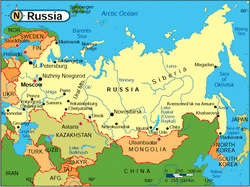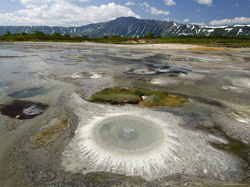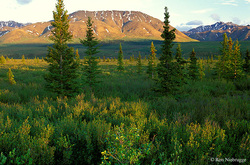Our next stop on our journey is Russia and the Newly Independent States.
Russia is the largest region in the world consisting of 12 countries: Belarus, Moldova, Ukraine, Georgia, Armenia, Azerbaijan, Kazakhstan, Kyrgyzstan, Tajikistan, Uzbekistan, Turkmenistan and Russia.
So let's take a look at some of the features that Russia and its Newly Independent states has to see.
The first feature we will look at is the Caucasus Mountains.
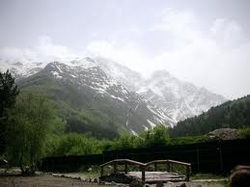
The Caucasus Mountains were formed 20 million years ago from the collision of the Arabian and Eurasian plate. The Caucasus Mountains are a dividing line between Asia and Europe with the northern part of the mountains in Europe and the Southern portion is in Asia. The western side of the mountains are bordered by the Black Sea and the eastern side by the Caspian Sea. The highest peak you will see is in Europe at 18,510 feet. These mountains are believed to be a continuation of the Himalayas.
The next feature we get to see is Lake Baikal.
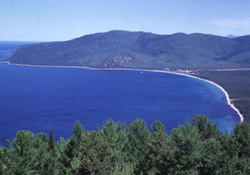
Lake Baikal or "Pearl of Siberia" is named for its beauty. This lake makes up 22% of the worlds fresh water and 80% of the water that is consumed by Russia. It is 5,314 feet deep and is 4,215 feet below sea level. When compared by size it is compared to the Great Lakes because of the amount of water that it contains. The water is so transparent that objects placed in the water can be seen as far as 140 feet deep. Lake Baikal contains up to 3,500 of the plants and animals in it. Experts say that it is growing in size up to 1 inch per year.
As we move along we are going to stop and look at the Uzon Caldera Volcano.
The Uzon Caldera Volcano is 10 km in diameter and was developed around 40 thousand years ago. It was given this name from its hollow like structure. It has hydrothermal activity that causes many eruptions of hot springs, geysers and mud spots which create depressions all over the surrounding land. Its elevation is 5,305 feet and the last recorded eruption was 300 years ago. The last recorded hydrothermal eruption was in 1989.
Now we will explore a body of water the Yenisie River.
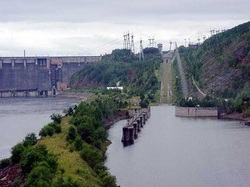
The Yenisie River is considered the world's 5th largest river. It is 3,534 miles long and flows South to North across Siberia through Mongolia and Russia. It is the boundary for the East and West part of the region. The river empties into the Kara Sea and is frozen most of the time. More than half of the water that makes up the river is from melted snow, 1/3 is from rain and the rest from ground water. The river creates a lot of flooding from all the ice jams that form. At the base of the river is the Taiga forest and is where you find most of the fresh water fish. Along the river damns are built for gold mining, logging, oil drilling and transportation.
The last feature we are going to check out is the Taiga Forest.
The Taiga Forest a/k/a Boreal Forest is the largest environmental region. It covers the Russian and Westerees Siberia plains. It is made up of mainly evergreen trees. Here the forest has long winters and moderate to high precipitation. Because of the location of this forest being in the Northern hemisphere, wild life is of few birds, ermines, beavers, red squirrels, lynx, martens, wolverines and moose.
Now that we have looked at a few of the features in this regions lets look at some facts.
Climate: In the Southern part of the region you will find Steppe. European Russia is Humid Continental, Siberia with Subartic (permafrost), and in the North Tundra. Along the Black Sea the winters are cool and Siberia has permafrost and is frigid. Along the Artic Coast summers are cool and in the Steppe they are warm.
Religion: The majority of the population is Russian Orthodox. The remainder of the population is a mixture of Muslim, Catholicism, Protestantism and Judaism. Russia is the largest region for non-practice of religion.
Population: The population of Russia and the Newly Independent States is about 1,45.5 million people. Most of the population lives in the Western part of the region and they live in the city. Life expectancy in this region is lower than most of the others. Siberia, because of the climate and landscape is most densely populated.
Resources: The resources found in this region come mainly from the mines. This region is the largest exporter of natural gas, coal, timber and metals. Sadly enough this does generate environmental issues. Russia and the newly Independent States are the most polluted region in the world. Air and water pollution are strong environmental hazards. The wells get polluted from all the water that drains into the ground from the air and mines. An oil pipeline busted in the previous years and the government did not find this at the time to be a problem. The contamination still exists. There is radiation contamination from the 56 different areas that are non-degraded environmentally. In 1986, there was a nuclear explosion in the Ukraine. The coal mining and metallurgical centers have polluted the air and water. Then there is the Steppe areaa that are dealing with soil exhaustion from the deteriorating forests.
The country of focus is Russia. Russia is the world's greatest reserve of natural resources. It is also the largest country in the world and has the largest economy. Even though this is true, most of the population is either in poverty or below the poverty line. There are not as many roads in this region as in North America. Most of the road way used is unpaved. The railroad is the most used and operated form of transportation.. Airplanes are used the most for passenger transportation. Because of the cold weather, especially in the winter, the North and South direction of the rivers water transport is limited. There are 6 cities that still use the underground subway for public transport and it is the least expensive of all the transportations there are in this region.
Religion: The majority of the population is Russian Orthodox. The remainder of the population is a mixture of Muslim, Catholicism, Protestantism and Judaism. Russia is the largest region for non-practice of religion.
Population: The population of Russia and the Newly Independent States is about 1,45.5 million people. Most of the population lives in the Western part of the region and they live in the city. Life expectancy in this region is lower than most of the others. Siberia, because of the climate and landscape is most densely populated.
Resources: The resources found in this region come mainly from the mines. This region is the largest exporter of natural gas, coal, timber and metals. Sadly enough this does generate environmental issues. Russia and the newly Independent States are the most polluted region in the world. Air and water pollution are strong environmental hazards. The wells get polluted from all the water that drains into the ground from the air and mines. An oil pipeline busted in the previous years and the government did not find this at the time to be a problem. The contamination still exists. There is radiation contamination from the 56 different areas that are non-degraded environmentally. In 1986, there was a nuclear explosion in the Ukraine. The coal mining and metallurgical centers have polluted the air and water. Then there is the Steppe areaa that are dealing with soil exhaustion from the deteriorating forests.
The country of focus is Russia. Russia is the world's greatest reserve of natural resources. It is also the largest country in the world and has the largest economy. Even though this is true, most of the population is either in poverty or below the poverty line. There are not as many roads in this region as in North America. Most of the road way used is unpaved. The railroad is the most used and operated form of transportation.. Airplanes are used the most for passenger transportation. Because of the cold weather, especially in the winter, the North and South direction of the rivers water transport is limited. There are 6 cities that still use the underground subway for public transport and it is the least expensive of all the transportations there are in this region.
Finally lets talk about some of the food in this region. The agriculture in this region consists of grain, sugar beets, sunflower seeds, vegetables, fruits, beef and milk. Some of the different foods you will find in this region is Beef Stroganoff, which is very much a favorite of mine. Meat and cabbage pies are made a lot and are made like we make our Pot Pies. The soup that is known for this region is "Borsh." I believe this soup is similar to the soup we eat "Boiled Diner." Then there is Pelmeni or "Siberian Dumplings that are made because they can be made dozens at a time and kept frozen. They are made and stored for the long winter months.
Resources:
123RF Stock Photos: Royalty Free Stock Photos. 123RF limited 2006-2010. Retrieved from http://www.123rf.com
Advanced International Translation (1998-2010). General Facts about Russia. Retrieved from http://www.stranslation.com
Central Intelligence Agency (no copyright). The Work of a Nation. The Center of Intelligence. Retrieved from http://www.cia.gov
Geology.com (2005-2011). Deepest Lake in the World. Retrieved from http://www.geology.com
Lake Baikal Co. (2010). Facts about Lake Baikal. Retrieved from http://www.lakebaikaltravel.com
Moscow Top News.com (2011). The wonders of Kamchatka: Uzon Caldera.. Retrieved from http://www.moscowtopnews.com
Nova Online (2007). Caucasus Mountains. Retrieved from http://novaonline.nvcc.edu
Pulsipher, L. M., and Pulsipher, A. (2008). World Regional Geography: Global Patterns, local lives (4th ed.). New York: W. H. Freeman and Company.
Securities Lending Times (2010). Country Focus-Russia. Retrieved from http://www.securitieslendingtimes.com
U.S. Library of Congress (no copyright). Russia-Environmental Problems. Retrieved from http://countrystudies.us
Yenisie River (2011). In Encyclopedia Britannica. Retrieved from http://www.briannica.com
123RF Stock Photos: Royalty Free Stock Photos. 123RF limited 2006-2010. Retrieved from http://www.123rf.com
Advanced International Translation (1998-2010). General Facts about Russia. Retrieved from http://www.stranslation.com
Central Intelligence Agency (no copyright). The Work of a Nation. The Center of Intelligence. Retrieved from http://www.cia.gov
Geology.com (2005-2011). Deepest Lake in the World. Retrieved from http://www.geology.com
Lake Baikal Co. (2010). Facts about Lake Baikal. Retrieved from http://www.lakebaikaltravel.com
Moscow Top News.com (2011). The wonders of Kamchatka: Uzon Caldera.. Retrieved from http://www.moscowtopnews.com
Nova Online (2007). Caucasus Mountains. Retrieved from http://novaonline.nvcc.edu
Pulsipher, L. M., and Pulsipher, A. (2008). World Regional Geography: Global Patterns, local lives (4th ed.). New York: W. H. Freeman and Company.
Securities Lending Times (2010). Country Focus-Russia. Retrieved from http://www.securitieslendingtimes.com
U.S. Library of Congress (no copyright). Russia-Environmental Problems. Retrieved from http://countrystudies.us
Yenisie River (2011). In Encyclopedia Britannica. Retrieved from http://www.briannica.com
